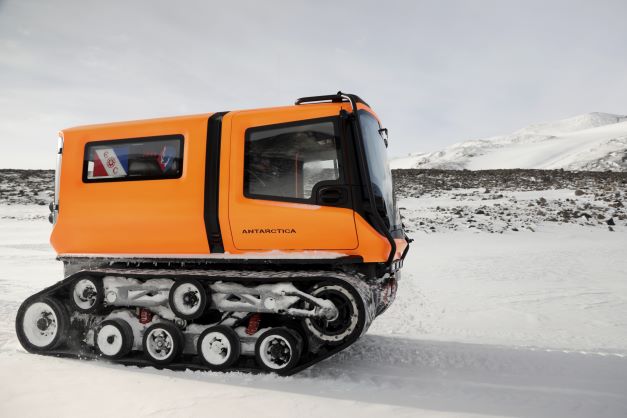The Princess Elisabeth Antarctica research station has received the first electric vehicle designed to be used in polar environments.
The Belgian polar station was founded by polar explorer Alain Hubert and the International Polar Foundation (IPF) in 2007. It was constructed from the very start as the first and, to date, only zero-emission station, with a view to maintaining a Belgian presence in Antarctica and pursuing its research ambition facing climate and environmental challenges.
The electric vehicle is also a world first: never before has an electric vehicle with caterpillar tracks operated in Antarctica. The vehicle is named “Venturi Antarctica” after Venturi, the high-tech company in Monaco which is specialising in the design and manufacture of high-performance electric vehicles.
The new vehicle was presented six months ago on World Environment Day (5 June) to Prince Albert II of Monaco. With its fold-down bench seats positioned lengthwise, it can carry 1 to 6 people, equipment and even a second battery to extend its starting range of 50 to 200 kilometres in temperatures as low as -50°C.
“Almost 12 years ago to the day, Prince Albert II of Monaco returned from a trip to Antarctica and told me that the scientific research stations did not have clean vehicles,” said Gildo Pastor, President of Venturi. “Through the Prince Albert II of Monaco Foundation, Venturi was then entrusted with the task of providing a zero-emission solution that would enable access to areas of scientific study.”
“Back then, in 2009, there was no technology that allowed such a vehicle to operate on rough terrain at -50°C,” he added. “This third version of the Antarctica is now optimal. My teams and I are proud to supply this vehicle to the International Polar Foundation.”
The e-vehicle will enable scientists based at the polar station to move around the region of East Antarctica with their equipment, while limiting disruption to the ecosystem as far as possible.
The first week of operations included maintenance work on several automated weather observation stations and the new Belgian atmospheric observation station located at an altitude of 2,300 metres on the Antarctic Plateau.
The first journeys also provided an opportunity to take snow surface temperature measurements, which are used to validate satellite measurements. In addition, the Venturi Antarctica vehicle enabled a simulated emergency rescue to be carried out, based on the scenario of extracting someone from the bottom of a crevasse.
The Princess Elisabeth Antarctica research station is located in Eastern Antarctica. The station is surrounded by a wide variety of research environments, from mountain ranges jutting out of the ice sheet, to wide dry valleys, huge ice fields and icy cold freshwater lakes that are almost always frozen.
The Brussels Times

